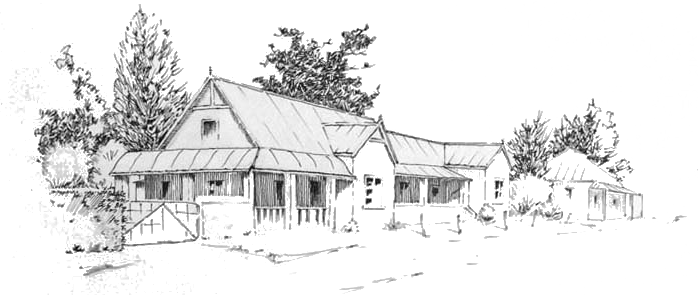TYING A PERFECT HIGH WATER RAB

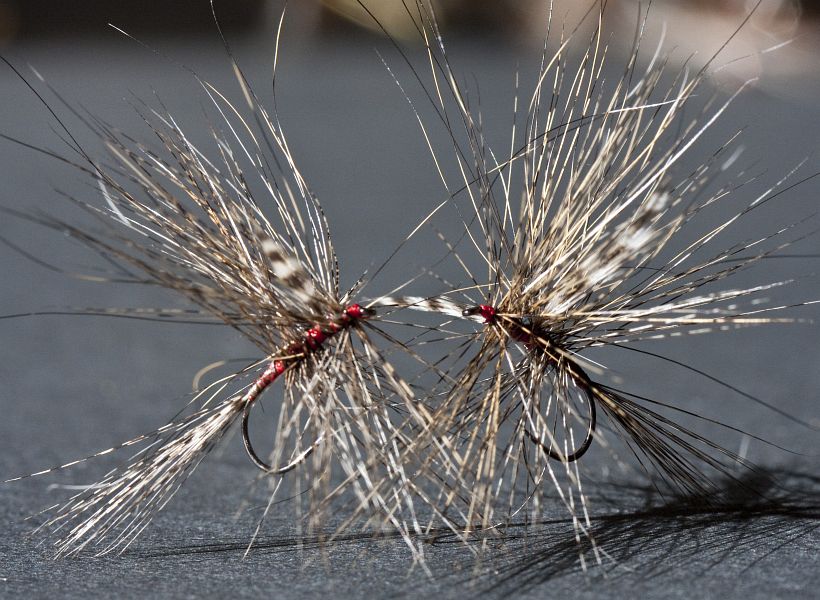
History
The RAB is one of the classically wide-hackle dry flies, where the great width of the hackle is the essence of the fly’s uniqueness. It’s generally from the dry fly family of Skaters and Variants, patterns that go back to William Baigent in Yorkshire in the early 1900’s and so loved by famous anglers like Edward Hewitt, Lee Wulff and Art Flick. The difference in the RAB is that the hackle is tied more broadly along the hook shank than with Variants and Skaters. The wide spread of hackle cushions the presentation, adds to the fly’s floatability and the long legs on a RAB add general interest, movement and life to the fly on the water.
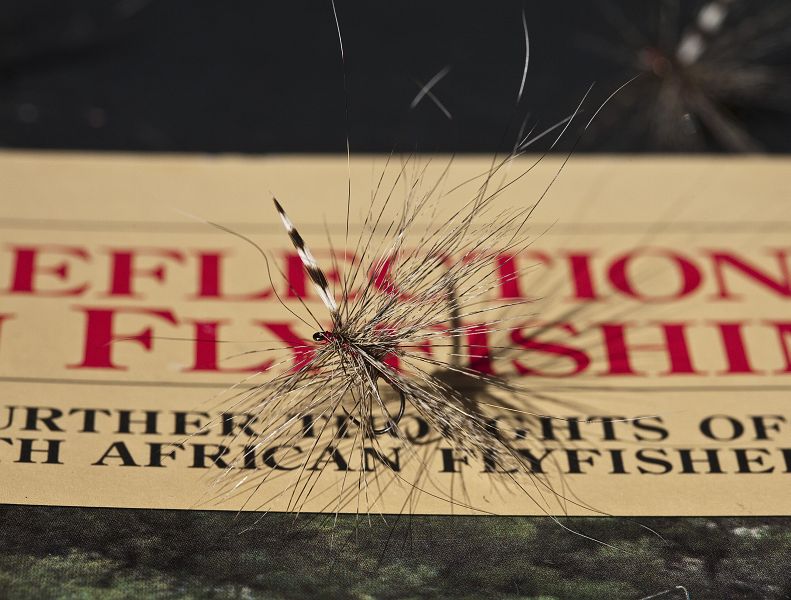
The RAB was this country’s premier dry fly on rivers and streams for years, the invention of a brilliant Western Cape fly fisher, Tony Biggs, who made the Cape streams his own in the 60’s and 70’s when he was the best fly fisher around. In essence, and as I remember the evolution of the fly, it was a mix of the influences of the then doyen of dry fly fishing in the Western Cape, Mark Mc Kereth, who often fished a ginger, palmer-hackled Wickham’s Fancy, and the Royal Wulff. The RAB was a beautiful fly to fish and was that effective it became the most popular fly on our streams. Tony Biggs eventually tied them commercially. They sold like hot cakes from Logans and Jack Lemkus sports stores in Cape Town who paid him R14.50 a gross! He said it was his beer money. I remember them sitting in a shoe box on the counter in the fishing section.
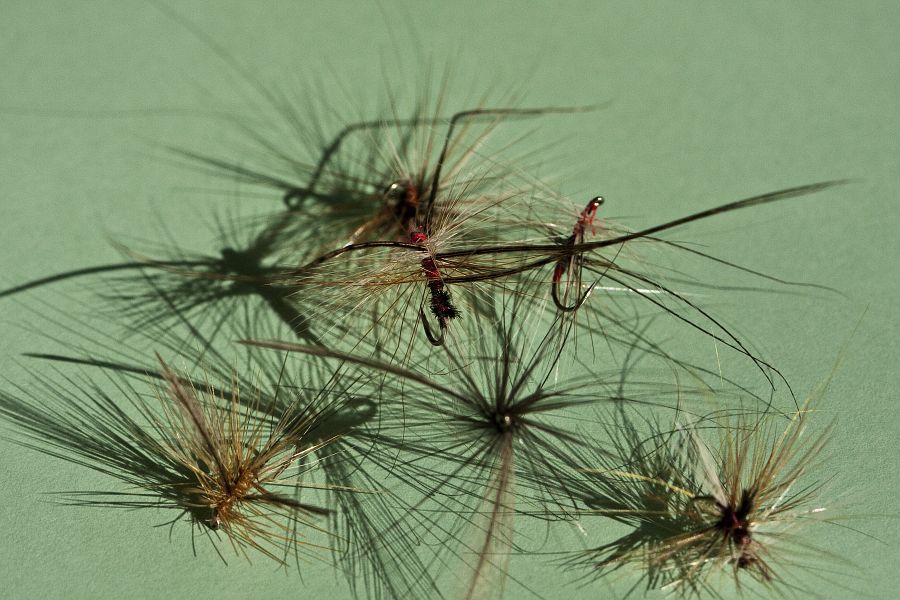
A half dozen of Tony Biggs RABs from the early days. Poor picture, but note the long legs (pheasant tail) on the fly in the centre, a true traditional version
Over the years other patterns have eclipsed the RAB, like the Parachute Adams and the Elk Hair Caddis (in its various guises), the Klinkhamers and various Cul de Canard patterns. But no dry fly I know is prettier for an angler to fish than a well tied RAB and very few are more productive when a stream is running well. What makes it pretty to fish is the gentleness of its presentation and the way it almost hovers over the water, lands then seems to tremble and dance as it weaves on its toes with the currents.
The original RABs were always more lightly dressed for low water and more fully dressed for high water. The hackles were always wide, very stiff, fine and as glossy as possible. Traditionally the front hackle was cream or white and the rear hackle either red or dark ginger. To create the impression of movement the fly had extra-long trailing legs, say five or six, coming off the body at different angles. This made for a wide, light and very visible dry fly that floated light as a balsa raft all day.
The big thing about RABs was getting hold of the right materials. First, the thread: Tony Biggs insisted on a perfect colour red. The thread had to be Ferrari red, not maroon, or scarlet. I use Danville’s red, but Biggs says it’s too dark. He preferred to buy spools of red silk from haberdashery stores because that way he could pick just the right colour.

Most free-range roosters with a gamecock bloodline provided suitable RAB hackles for us in the early days, but they were always better when they came off a bird more than two years old and in prime plumage. New plumage has more sheen and gloss and the barbs are stiffer. In older birds there was also far less webbing in the hackle tips. Most of these hackles we bought off farmers who happened to have a few good roosters hanging around the yard so in the 60’s and 70’s we always went fishing with a supply of envelopes, a pair of scissors and some small change. It always seemed to me that what we were actually paying for was catching the bird, not for its feathers. Mature roosters are pretty quick and they have a neat side step! We’d snip off the best hackles, pile them into an envelope, hand over 50 cents, and be gone. The whole operation could take less than 15 minutes!

A piece of history - one of my envelopes from around 1967 with the actual clippings I took. Left top are RABs tied back then by Tony Biggs himself
Then genetic American hackle arrived, as well as some useful Indian and Chinese capes, and that made life easier, though I never saw hackles quite as good for RABs as we got off the ‘roadside Metz’ roosters we plucked.

Indian Neck - some work well for RABs
Traditionally, the first of the two hackles was lighter and tied more narrowly over the front of the hook shank. The second, the rear hackle, was darker and tied more widely, two turns at least more than the front hackle. The hackles were natural reds, dark ginger, even black, later shades of dun (when dun capes finally became available), but up front you wanted a cream to off-white hackle. Badgers also worked. The theory was the lighter hackle up front acted as a ‘spotter’. In practice, I’ve seen Biggs use light duns up front instead of white and they were just as easy to track simply because a hackle this wide is hard to miss, whatever the colour.
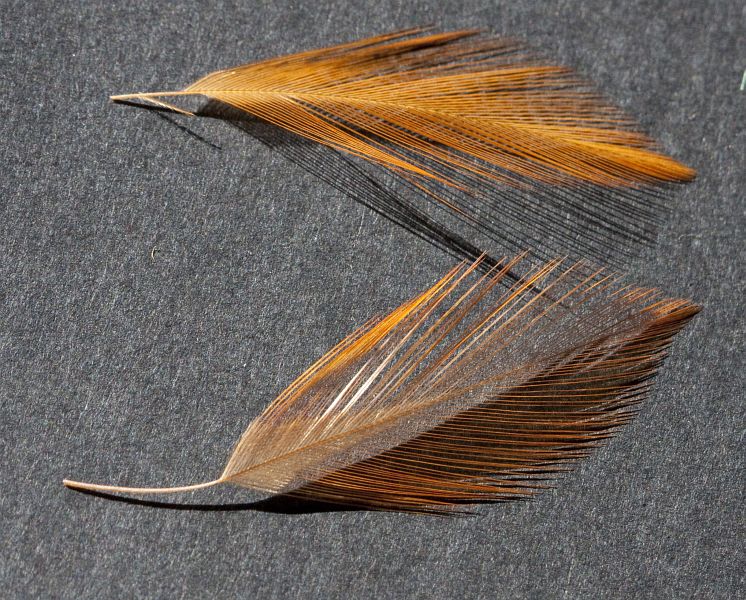
Spade hackle - good for tailing but either of these would make a perfect RAB hackle

A spade with too much web. Good only for tailing
In RABs much more depends on the characteristics of the hackle than its colour. The hackle must be web-free, stiff and wide, the sort of feather Veniard called a Spade hackle, the short, broad shoulder hackles on the sides of a cape. Spade hackles tend to be wider and have less web, but because there aren’t that many of them on a cape, both Tony and I mainly used them for tailing. We get our tying hackles these days from the web-free tips of the large hackles on genetic, Indian or Chinese capes.

Selecting a large hackle from a genetic cape looking for hackle tips with minimal web
Lately I’ve started using Coq de Leon saddle hackles and not caring too much whether the front hackle is that much lighter. These CdL saddles, or the full Coq de Leon capes, are now unbeatable materials for high quality RABs.

Capes - duns, grizzle, red and Coq de Leon saddle
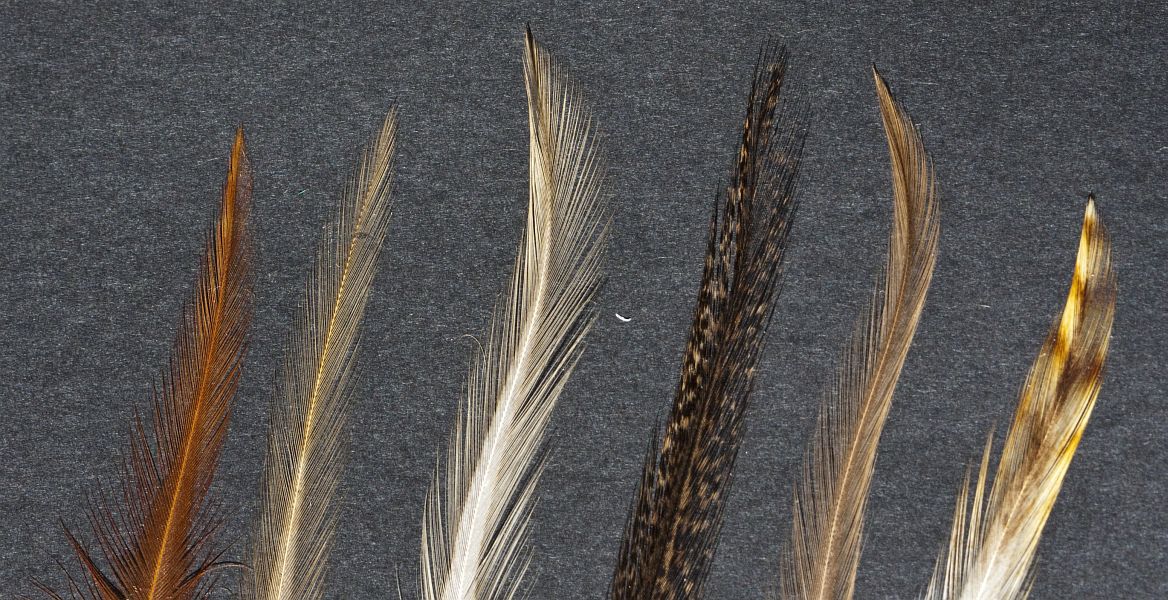
Various RAB hackles all taken off genetic capes (with the exception of the CdL hackle 3rd from the right). These hackles are a windfall on a genetic cape because they are normally too large to be used on dry flies!
For the legs, long fibers off a heron tail, or the tail fibres of a blue crane, were highly prized, and can be considered deeply traditional, though not used by us anymore. Most of the commercial RABs still have legs of cock pheasant tail fibres, or peacock herl, or Egyptian goose wing primaries, mainly because they are easy to source. They are not that good though because they are too bulky and stiff to give the trailing legs enough movement.

Coq de Leon saddles are beautifully speckled, wide, spiky and relatively inexpensive
A recent answer to RAB legs are the long fibres from a Cape squirrel tail (English squirrel, exotic animals in the Cape and I see road kills ever week in Cape Town). Water mongoose guard hairs also work well, though these days I stick with squirrel tail because the fibers are longer and softer, nicely banded and easier to source.

Cape squirrel tail
I happen to like RABs tied with spent wings (and so did Tony Biggs), either grizzly or dark or pale dun cock hackle tips. This is still deeply traditional, or at least in keeping with some of the original patterns, although it is optional. I just think spent wings make RABs look more attractive.

A dark RAB tied with dun hackle wings by Tony Biggs circa 1980
Ingredients
Thread: Red Danville 8/0 or equivalent
Hook: Light wire dry fly hook with a wide gape and slightly long in the shank. Useful makes and models to consider are Grip Hook’s model 11011 BL (seen here in the fly being tied), Tiemco’s 900 BL or 100 BL, Daiichi’s # 1190, Kamasan’s B 402 and Gamakatsu’s S 10-3F.
Size 14 is probably most popular, but 12‘s and 16’s work nicely and tying a few on 18’s for low water, or selective trout, is useful. But that’s about as small a hook as you can use. It’s not practical to tie RABs on hooks smaller than 18’s.
Tail: Cock hackle fibres mixed if you like
Body: a single, stripped peacock quill (from the blue section of the eye of a tail feather) wrapped with red tread
Wings: Small hackle tips from any cape you like, but grizzlies are brilliant
Hackles: Coq de Leon saddle or the web-free tips of the larger hackles on any other cock cape in black, red, ginger, cream or dun
Legs: Squirrel tail fibres
How to tie this fly:
Fundamental to the success of this whole exercise is to remember that the back third of the shank belongs to the body and the middle and front thirds are for the hackle and wings.
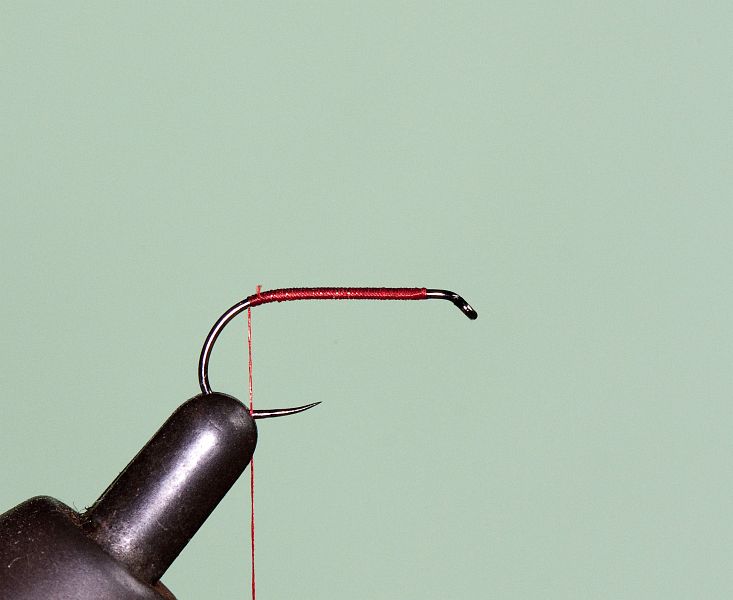
Wrap the shank with red tying thread. Pluck off around ten long, stiff cock hackle fibers, CdL, red or ginger, or mix some colours, even throw a few white ones in if you like. I’m not sure fish notice the difference, but mixed tail fibres are more in line with the original pattern. Measure the fibers against the hook shank to make sure you tie them long – about 1 to 1½ times shank length. Start tying the tail at the back end of the shank and bring the silk forward until the tail butts cover the back third of the shank the snip off. Fan out the fibers by pulling down hard on the silk after the first wrap, otherwise the tail will be too dense and too straight. You don’t want a bulky, cigar-shaped tail on a RAB.

Prepare tie in the body material – one stripped peacock quill. Trap the quill and wrap it back to the tail and then forward again. Tie it off. Wrap a few turns of red thread over the quill body to help strengthen it and to add a little colour. (Remember RAB stood for red arsed bastard).

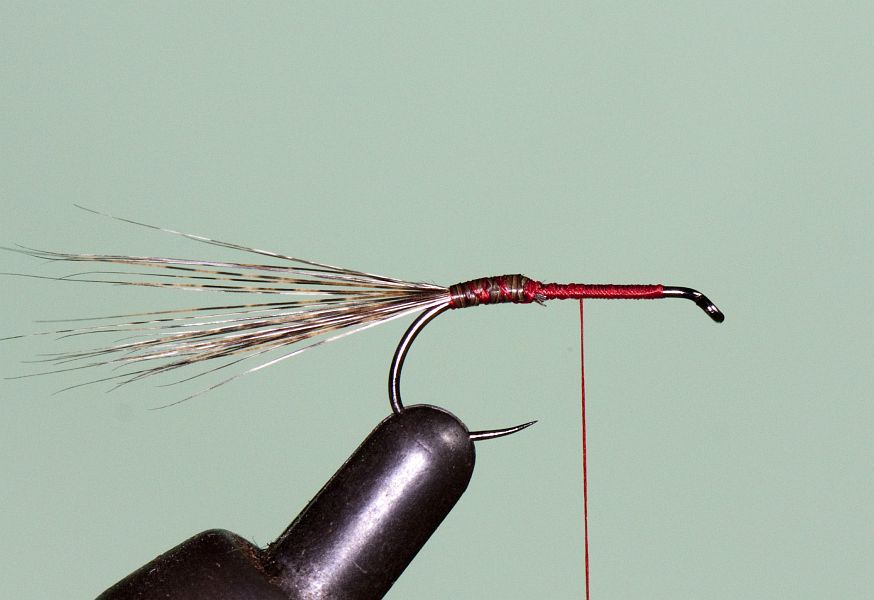
Note the wings will be tied in roughly mid shank
Select two small hackle tips for wings (about size 18-20 if you were tying them as hackles for a dry fly) and place them with their convex sides facing together. The wings need to be just a bit longer than the hook shank. Tie them just ahead of the center of the shank, wrapping thread over them. Trim the butts and leave the wings facing forward, flat and un-split for the moment.
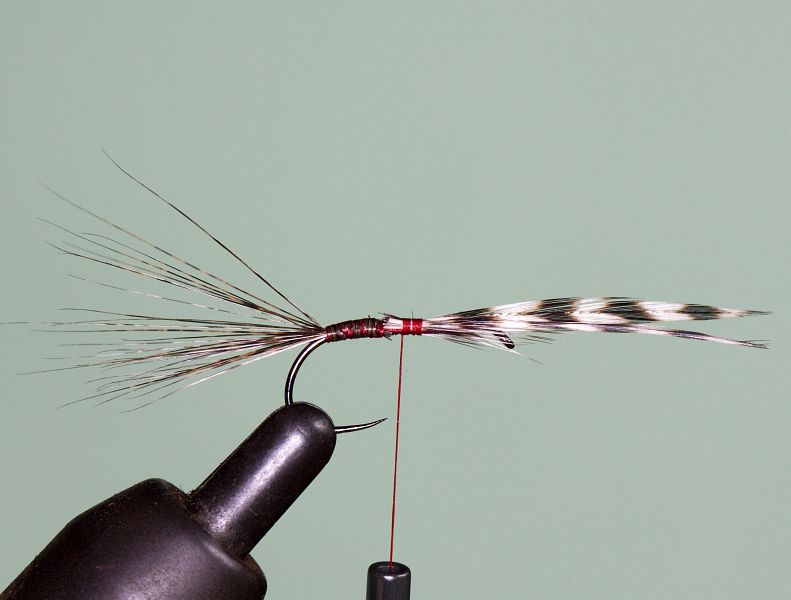
Now tie in six or more squirrel legs, roughly twice the width of the hackles, maybe longer, but never shorter. By holding the material against the hook shank you can measure this perfectly. You really want to get this right because long legs are half of what a RAB is all about. Tie the legs all in one bunch just behind the wings and leave them standing in whatever position they happen to take up. You will work on them later.
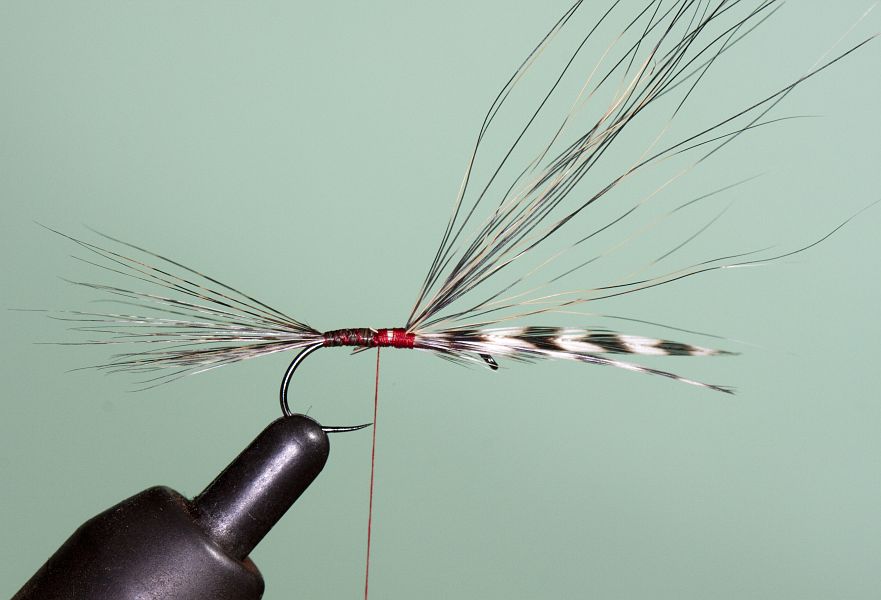
Now move the silk back to the abdomen. We’re back at the last third of the shank with a nice long tail on the fly and the body tied in and wrapped with a little red silk. The squirrel legs are still there waiting for attention just behind the spent wings also waiting for attention.

The tying thread has spread the legs nicely
Choose a hackle around twice the width of the gape. The rear hackle is traditionally darker – red, brown, dark ginger, black, dun or Coq de Leon. Tie the hackle stalk in where the body ends, with the shine facing forward, though this is not crucial. Take the thread up to where the legs are seated, then splaying out a few legs with careless wraps so you go. Don’t worry to get their positions exactly right. It’s irrelevant.
Now split the wings, spread them out flat (spent) and anchor them with figure of eight turns of thread.

The wings are split, the front hackle is in and the thread is back behind the rear hackle
Take the thread to 3mm behind the eye (you must leave space for the head) and tie in the second hackle, preferably a different colour hackle and a lighter shade than the rear hackle, also with the shine facing forward.
Now, bring the silk all the way back to behind the first hackle threading carefully past the and again through the legs, until the thread is behind the stalk of the rear hackle. Now wind the rear hackle forward to right against the spent wings, not worrying about trapping the odd squirrel leg fibres as you go, just trying to spread them out a little.
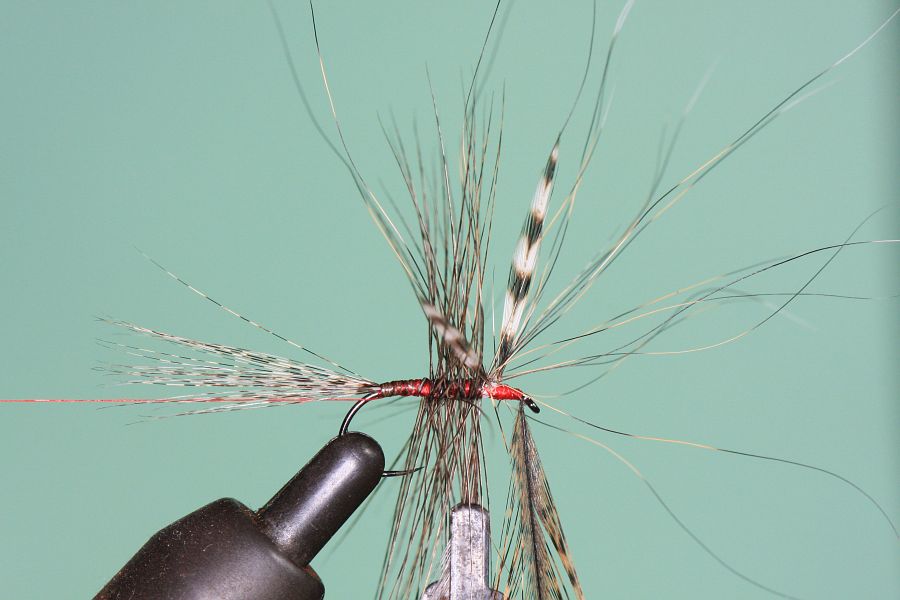
The rear hackle wound on. Note the thread has still to be wound through this hackle
Keep the hackle pliers on the wound rear hackle tip and then wind your tying thread through the hackle. This may feel strange, because mostly we don’t hackle dry flies this way. But stay with me. A little sideways shaking of your bobbin hand helps the thread to slip between the hackle fibers and legs. Once the rear hackle is securely anchored trim off the excess.
Wind the front hackle back towards the first hackle going right in among its fibers or at least right up against them. Now bring the silk forward through the front hackle, just as you did with the rear hackle, until you are at the head. Trim off the second hackle excess and put in a half hitch here. Now build up a head. You can varnish or glue the head if you like, but personally, like Tony, I never bother.

The front hackle has been wound back to the tying thread just behind the wings

In the same way we threaded through the rear hackle we thread through the front hackle to the eye

Final RAB but the wings are hard to see

A high water RAB with honey dun upright wings - a variation I like for the Cape streams
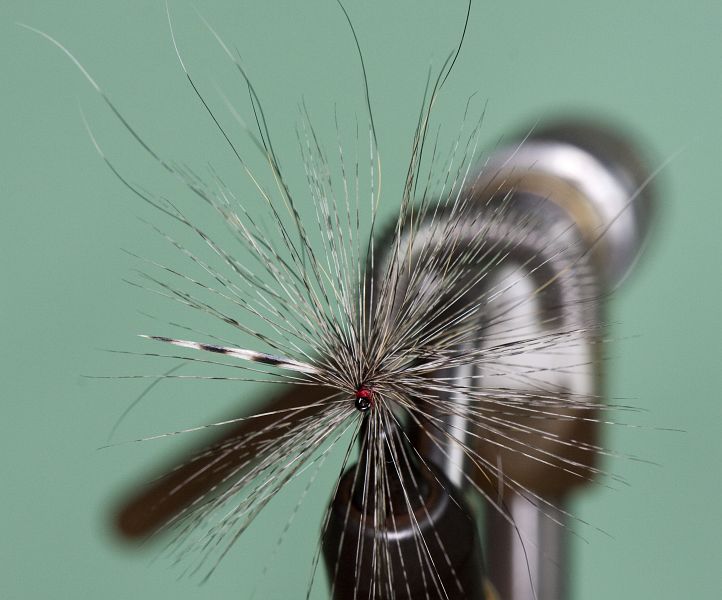
Seen from the front this picture gives you an idea of the great width of the RAB hackles and the length of the wings
Tie a dozen RABs, put them in the palm of your hand and blow across them. The fibers should dance and vibrate and if you blow hard enough, the flies should lift off your hand and fall softly to the ground like wind-blown dandelions.

RABs in different guises. Note the one on the left is traditional and the one in the right front is winged with light dun hackle tips
Fishing the RAB
The wide profile of the RAB, and its exquisite lightness make it spin in the cast and that’s inclined to twist the tippet. You can overcome this to some extent by using a Surgeon’s swivel knot to attach the fly. The idea is to let the fly spin loosely around the tippet by creating a knot in the tippet large enough that it won’t pass through the eye. You can do this by threading the tippet through the eye then knotting the end to a thicker diameter of nylon by means of a Surgeon’s knot. Trim off well.
High water RABs fish well in riffled water and in runs with an uneven surface that rock the fly in the drift and add movement to it. Remember when fishing RABs to flick the water out of them with the occasional snap cast.

Classic RAB water - Lindesfarne Bridge, Sterkspruit River

RAB water at its best - aim for the seam line on the right of the main current flow

High water RABs. Note how the grizzly hackle wings add nice contrast. Note also the length of the trailing legs
Below, the Bokspruit on the summit of the Drakensberg. The whole seam from the white water at the top of the run, right the way along the far bank tight under the grass is ideal. This fish took Ed Gerber's RAB at the neck of the run in the broken water.


All images, art and text are copyright protected © 2010
No content may be reproduced without written consent by the Author and Owner.

